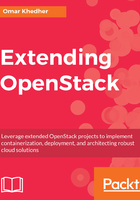
Growing the OpenStack infrastructure
The ultimate goal of the Infrastructure as Code approach is to improve the confidence of the systems running in production. In addition, this can be coupled with infrastructure growth. Expanding the OpenStack layout, for example, cannot be achieved without taking into account an agile approach that keeps its different components across the data center running without interruption. Moreover, adding new components or integrating a new service into the OpenStack ecosystem setup will result in a design change. New components should talk to existing ones with few new resource requirements. This challenge can be delegated to a Version Control System (VCS). Whatever changes are made, keeping the OpenStack setup self-descriptive in VCS through definition files and scripts will define the desired state of the private cloud. This avoids any process that would end up reinventing the wheel; while it needs only to expand and correlate code describing the existing OpenStack setup.
To ensure that the OpenStack infrastructure resists changes as the code that describes it grows, a very agile way must exist to emphasize system configuration changes. This can be inspired by software development practices. This enables us to apply modern software development tools to deploy and extend an OpenStack infrastructure, for example. At this stage, a DevOps movement has appeared that brings software developers and operators together to collaborate. Of course, exploiting the new modern approach and its derived practices and ideas will bring beneficial results when growing or upgrading your OpenStack private cloud environment.
The next diagram resumes a simplistic shape of a standard change management life cycle for the deployment infrastructure code of OpenStack:

The different stages can be discussed as follows:
- Plan and design: The very early stage of planning the general layout of the OpenStack infrastructure and the related components that are willing to install, integrate, and deploy them.
- Development stage: This involves running tests for the latest versions of the infrastructure file definitions. In general, local tools, such as Vagrant and other virtualized local test environments, are used to test the changed files and commit them to a VCS.
- Build and unit test stage: Once a change is committed to VCS, a phase of code validation will be managed by a Continuous Integration (CI) system. It will run several activities or jobs by checking the syntax, code compilation, and unit tests.
- Code packaging and release: The CI tool should give a green light to process the changes. In this stage, the build has been done successfully and the configuration artifact will be packaged to be available for later phases.
- Test staging: At this stage, several tests should be executed on similar production environments. The most effective infrastructure code test runs on multiple stages. For example, you should start with a first test stage for one OpenStack service on its own. Then, you should propagate the first test with the second one by integrating other OpenStack components.
- Deploy to production: That applies in the final stage where the modeled changes that have been tested will be applied with zero downtime. Some great release techniques can be engaged at this stage, such as Blue-Green deployment.
- Operate in production: This is the very last stage where it proves the degree of consistency of the last changes in a running production environment. It should also be possible to roll the changes out quickly and easily.